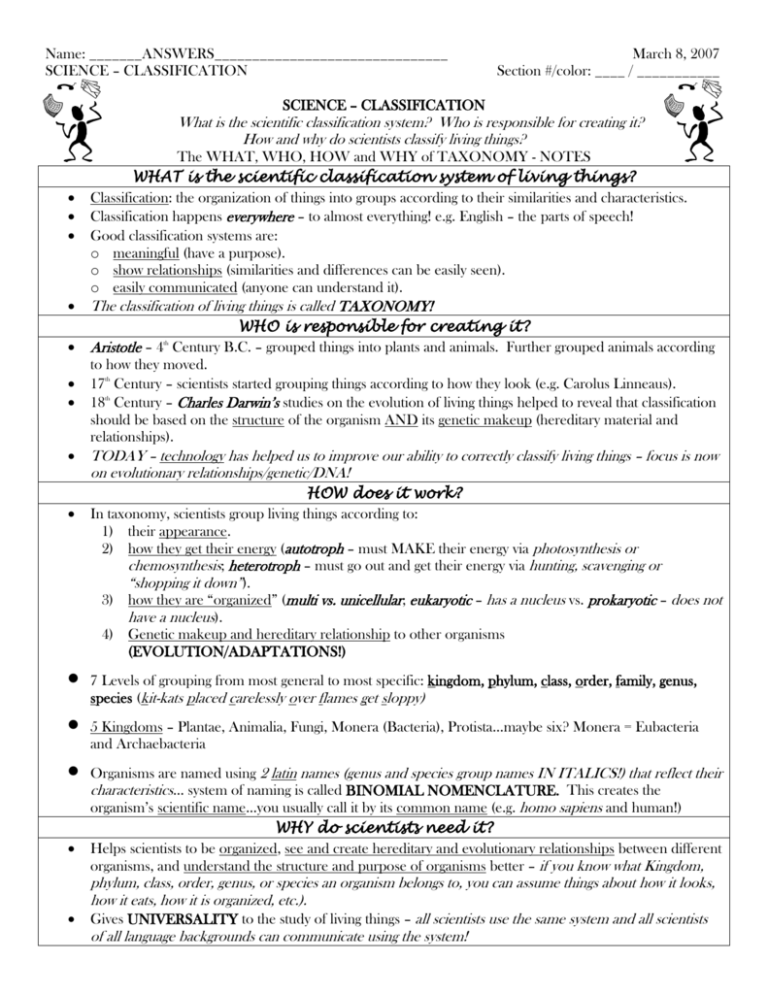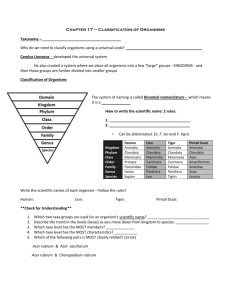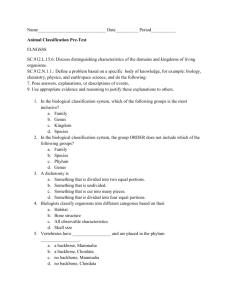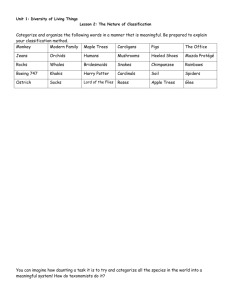CL3
advertisement

Name: _______ANSWERS_______________________________ SCIENCE – CLASSIFICATION March 8, 2007 Section #/color: ____ / ___________ SCIENCE – CLASSIFICATION What is the scientific classification system? Who is responsible for creating it? How and why do scientists classify living things? The WHAT, WHO, HOW and WHY of TAXONOMY - NOTES WHAT is the scientific classification system of living things? Classification: the organization of things into groups according to their similarities and characteristics. Classification happens everywhere – to almost everything! e.g. English – the parts of speech! Good classification systems are: o meaningful (have a purpose). o show relationships (similarities and differences can be easily seen). o easily communicated (anyone can understand it). The classification of living things is called TAXONOMY! WHO is responsible for creating it? Aristotle – 4 Century B.C. – grouped things into plants and animals. Further grouped animals according to how they moved. 17th Century – scientists started grouping things according to how they look (e.g. Carolus Linneaus). 18th Century – Charles Darwin’s studies on the evolution of living things helped to reveal that classification should be based on the structure of the organism AND its genetic makeup (hereditary material and relationships). th TODAY – technology has helped us to improve our ability to correctly classify living things – focus is now on evolutionary relationships/genetic/DNA! HOW does it work? In taxonomy, scientists group living things according to: 1) their appearance. 2) how they get their energy (autotroph – must MAKE their energy via photosynthesis or chemosynthesis; heterotroph – must go out and get their energy via hunting, scavenging or “shopping it down”). 3) how they are “organized” (multi vs. unicellular; eukaryotic – has a nucleus vs. prokaryotic – does not have a nucleus). 4) Genetic makeup and hereditary relationship to other organisms (EVOLUTION/ADAPTATIONS!) 7 Levels of grouping from most general to most specific: kingdom, phylum, class, order, family, genus, species (kit-kats placed carelessly over flames get sloppy) 5 Kingdoms – Plantae, Animalia, Fungi, Monera (Bacteria), Protista…maybe six? Monera = Eubacteria and Archaebacteria Organisms are named using 2 latin names (genus and species group names IN ITALICS!) that reflect their characteristics… system of naming is called BINOMIAL NOMENCLATURE. This creates the organism’s scientific name…you usually call it by its common name (e.g. homo sapiens and human!) WHY do scientists need it? Helps scientists to be organized, see and create hereditary and evolutionary relationships between different organisms, and understand the structure and purpose of organisms better – if you know what Kingdom, phylum, class, order, genus, or species an organism belongs to, you can assume things about how it looks, how it eats, how it is organized, etc.). Gives UNIVERSALITY to the study of living things – all scientists use the same system and all scientists of all language backgrounds can communicate using the system! Classification Notes Review Questions - ANSWERS DIRECTIONS: Use your notes on CLASSIFICATION to answer the following questions. Write/type your answers in complete sentences on a separate sheet of paper. 1. In your own words, what is CLASSIFICATION? The system in which the traits and characteristics of objects/ things are used to group them FOR A PURPOSE. 2. Suppose your friend wants to make a classification system for her DVD collection. She has DVD’s from all sorts of movie genre: horror, romance, adventure, sci-fi, etc. She tells you that she needs advice on making her classification system “GOOD.” What advice would you give her? Include in your answer examples of HOW she could arrange her DVD’s to meet the standards of a “GOOD” classification system. The system would need to have a purpose (i.e. for easy access of movies), show relationships (she could group them according to movie genre then maybe by date), and be easily understood (she could have dividers that show the different groups or place the movies on different shelves). 3. What is taxonomy, what is its purpose, and who is it used by? The system that scientists use/follow to classify and study living things. The purpose of TAXONOMY is to make it easier for scientists to study organisms/relate them, be organized, and communicate w/ other scientists more easily – UNIVERSALITY. Scientists – especially biologists, ecologists, botanists, zoologists, any scientist that studies/works w/ living things. 4. Describe how the systems used to classify living things have changed over time. What did we used to base our classification of living things on? What do we now base it on? Technology has helped us better understand the evolutionary relationships between organisms – we better understand their DNA and how they are connected not only in physical appearance but also at the cellular level. We used to base taxonomy only on physical appearance and now we look at genetic make-up also. 5. Explain how technology has helped us to change the methods that we use to group living things. See above – the microscope and other technological advances give us the ability to look at the interior, microscopic characteristics of organisms and compare them on the cellular level. We have also increased in our knowledge about evolution of organisms. 6. You are a scientist working in the pristine rainforests of Brazil. One day while studying the undergrowth of the forest, you stumble upon a strange creature. After your initial observations, you conclude that you have discovered a new species of living things. In order to classify your newly discovered species properly, what important characteristics of the organism would you need to study or find out about? Appearance, their method of obtaining energy (hetero/auto), how they are organized (multi vs. uni, eukaryotic/prokaryotic), genetic make up and evolutionary relationships/adaptations. 7. What is the LARGEST classification group in taxonomy? Smallest? KINGDOM…SPECIES 8. Can there be more than one type of organism in a single type of species group? Why or why not? NO – Species are a SINGLE kind of organism…like a species group is HUMANS. Species can only reproduce w/ other organisms of their OWN specie group. 9. Describe the two ways that we can name organisms. Which of the two ways can ALL scientists understand? Common name (plain English name – e.g. HUMAN) and SCIENTIFIC NAME (binomial nomenclature – a two part name based on the species and genus of an organism – in LATIN!). All scientists will understand the scientific name. 10. You are talking to a scientist who doesn’t believe in the taxonomic system of classification of living things. In fact, he doesn’t believe in any system of classification of living things. He says that it’s “a waste of time being so tedious about arranging every living thing out there into groups.” What would you respond to the scientist to convince him that his thoughts are incorrect? Give at LEAST three pieces of evidence to convince him to change his thinking. Classification of living things helps scientists be organized, see relationships/understand organisms better, and communicate w/ other scientists easily! 11. Go to http://en.wikipedia.org and type in the name of your assigned organism. Your assigned organism is:___________________________. Use the encyclopedia entry to fill out the attached chart to show the classification of your organism. Write a few sentences about your organism in the space provided in the chart. Finally, find a picture of your selected species and draw or cut and paste the picture into the box provided at the top of the chart. This activity is important for an upcoming in-class activity on DICHOTOMOUS KEYS. THE ABOVE 11 QUESTIONS ARE DUE ON: ___________________________________________________. ORGANISMS TO ASSIGN: See next page! Organism Giraffe Kingdom Animalia Phylum Chordata Class Mammalia Order Artiodactyla Family Giraffidae Genus Specie Giraffa G. camelopardalis Seahorse Animalia Chordata Actinopterygii Syngnathidae Hippocampus H. Denise Domestic Horse Animalia Chordata Mammalia Gasterosteifor mes Perissodactyla Equidae Equus E. caballus Cow Hartebeast Guinea Pig Domestic Pig Hine’s Emerald Dragonfly Two-spotted Lady beetle Euglena Paramecium Amoeba Volvox Black Bread Mold Escherichia Coli Poison Ivy Norway Maple Animalia Animalia Animalia Animalia Animalia Chordata Chordata Chordata Chordata Arthropoda Mammalia Mammalia Mammalia Mammalia Insecta Artiodactyla Artiodactyla Rodentia Artiodactyla Odonata Bovidae Bovidae Caviidae Suidae Corduliidae Bos B. taurus A. buselaphus Sus Somatochlora S. scrofa S. hineana Animalia Arthropoda Insecta Coleoptera Coccinellidae Adalia A. bipunctata Protista Protista Protista Protista Fungi Euglenozoa Ciliophora Amoebozoa Chlorophyta Euglenoidea Oligohymenophorea ? Chlorophyceae Zygomycetes Euglenales Peniculida ? Volvocales Mucorales ? Parameciidae Amoebidae Volvocaceae Mucoraceae Euglena Paramecium Amoeba Volvox ? P. aurelia A. proteus Rhizopus R. stolonifer Bacteria Proteobacteria E. coli Magnoliophyta Magnoliophyta Enterobacteria Enterobacteriaceae les Sapindales Anacardiaceae Sapindales Aceraceae Escherichia Plantae Plantae Gamma Proteobacteria Magnoliopsida Magnoliopsida Toxicodendron T. radicans A. platanoides Alcelaphus Cavia Acer C. Nana









